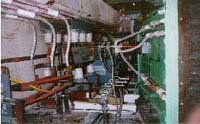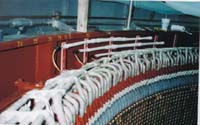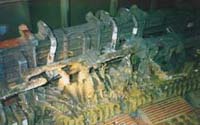WHAT ARE PARTIAL DISCHARGES?
Partial Discharges (PD) are "sparks", surges of electrons and ions occurring in voids and gaps within or adjacent to the insulation of High Voltage machines.
Partial Discharges are significant contributors to the progressive deterioration (aging) of the High Voltage insulation and its failure.
Partial discharge creates Ozone which bonds with Nitrogen and moisture from the air, creating Nitric acid that destroys the insulation.
PDA testing is used to monitor quality of the stator insulation while the generator is in service.
By detecting rapid deterioration in insulation, PDA gives an early warning and helps prevent catastrophic in-service failures, costly repairs, and unplanned outages.
Why monitor partial discharges?
No stator winding is perfect and PD activity starts mostly from the first day of operation. Stator bars have varying amounts of air pockets within or adjacent to the insulation, from the first day of operation. Under electrical stress these gas pockets break down producing sparks, which deteriorates quality of the winding insulation. This process, combined with other stresses, leads to a complete break down and a catastrophic in-service failure.PDA test can identify the severity of main winding problems such as:
| SLOT DISCHARGES | |
| INTERNAL DELAMINATION | |
| INTERNAL VOIDS | |
| GAS POCKETS | |
| LOOSE WINDING | |
| ENDWINDING DISCHARGES |
Stator winding is the most expensive electrical element of a generator or motor. According to the hydro utilities statistics, stator winding is the most common electrical problem and is the most expensive to fix.
Any in-service failure of generator winding is catastrophic and very costly to repair. PDA test allows maintenance to be based on the actual winding condition rather than time based maintenance.
 |

|
| PD sensors on small hydro generator terminals | PD sensors inside 150 MVA hydrogenerator |
How do we test for the PD activity?
Test is taken on-line during regular "normal" working regimes and does not need outages.
The on-line test is not destructive like some off-line tests and can be performed when needed, without interrupting normal operation.
| PDA test gives opportunity to instantly control effectiveness of repairs on the winding. | |
| PDA test is used by hundreds of utilities worldwide on thousands of generators and motors. | |
| PDA test is on-line, under normal working conditions when all mechanical and electrical stresses are present. | |
| PDA monitoring gives warning of winding deterioration before a serious problem occurs allowing the repairs to be simple and inexpensive. |
 Multimillion
dollar damage on a stator winding
Multimillion
dollar damage on a stator winding
In the event of an in-service failure, there would be tremendous repair costs as well as loss of production cost, which could be much greater.
Back to Top contact us: infrm@levico.com